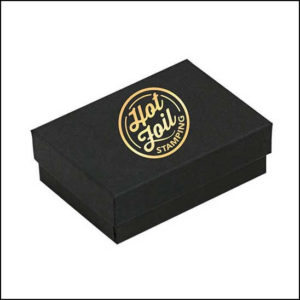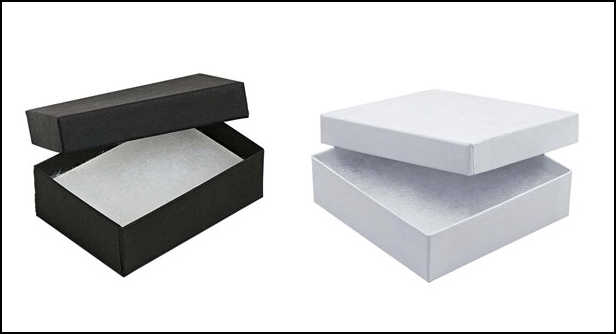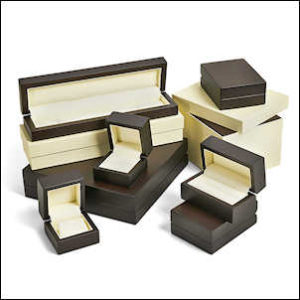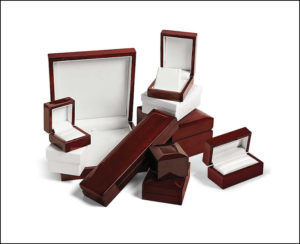The Silent Salesman
Professional marketers apply the term “silent salesman” to packaging, displays, and signs designed to increase sales and profits.
Customized and meaningfully real experiences resonate with consumers, and it is how jewelers can set themselves apart from the rest, underscores Nathan Button, merchandising director for Rio Grande, a Richline company. “Displays instantly present your products, setting forward that initial perception of your, brand. And that perception needs to carry through as it leaves the store in the packaging. Wowing the recipient every time the jewelry box is opened!”
 Keeping consistent elements within the brand, from logo to color choices and distinct details, over time fosters familiarity, reminds Button. “Obviously, begin with your business logo and preferably a distinct color. From there the focus needs to be on meaningfully accents and elements. Things like wrapping the box in a heavy coarse bow or including a handwritten note on the back of each brand tag. There’s a balance to be achieved with being familiar while unique.”
Keeping consistent elements within the brand, from logo to color choices and distinct details, over time fosters familiarity, reminds Button. “Obviously, begin with your business logo and preferably a distinct color. From there the focus needs to be on meaningfully accents and elements. Things like wrapping the box in a heavy coarse bow or including a handwritten note on the back of each brand tag. There’s a balance to be achieved with being familiar while unique.”
Visual Merchandising
Visual merchandising is an essential part of selling and one of the keyways of creating a brand experience, imparts Pam Levine, president of Levine Luxury Branding, who shared her perspectives on visual merchandising in a Plumb Club podcast. “The ultimate goal of successful and engaging product presentations is to inspire customers to touch, try on and buy.”
The “silent seller,” visual merchandising expresses and impresses your brand experience in the hearts and minds of your customers. “What customers see plays a huge role in how they feel and react. These visual cues lower the barriers and relax the defenses, putting customers at ease, giving them choices and directions to engage and explore.”
Retailers should consider their merchandise presentations; window displays and environment as their “space of engagement.” “What your customer sees, plays a huge role in how your customers feel and react,” Levine shares. “Think of the customer experience as a story. Use your space to cast your products into the drama told against a backdrop of textures, materials, color, form, and dimension.”
Levine advocates the use of signs and imagery to tell stories and give cues about a product. Lifestyle photos share ways to mix and match jewelry. Price signs can work if presented in good taste and if showing prices fits your sales strategy. Transparency and information are silent ways to express key brand values. She also encourages jewelers to cross merchandise seemingly unrelated to show customers the relationships between them. The idea is to remind customers of something they want or need that wasn’t on their mind to buy that day.”
Sharon Pisciotta for Quality Gold’s packaging and display division shares that jewelers are looking for something new in leatherette, and the company’s latest launches in metallic/pearlescent shades of gray and taupe are generating a lot of excitement.
Regarding props Pisciotta shares that beautiful trinket boxes by Quality Gold’s Luxury Giftware by Jere brand are popular elements that jewelers can add to a showcase, as well as a product for sale, in motifs like animals, birds, fish, and seasonal icons.
Levine encourages jewelers to consider props carefully, as less is more. “Make sure your décor choices fit with the brand experience you are trying to create,” she says, underscoring that the goal is to draw the customer’s eye through a logical progression.
Packaging with Purpose
Packaging is an essential component of a brand’s value and a shopper’s experience — a trigger for what you are creating in your store and the emotional responses that elicits in your customers. Tiffany is perhaps the best example of outstanding use of color in branding, as the iconic robin’s egg blue, with that white bow, evokes a Pavlovian response that something precious is inside.
 A little detail that makes a big impression, packaging should be treated as an integral part of your marketing strategy that helps to define who you are as a brand, underscores Pisciotta. Packaging is a way to extend the care you take in creating your store into a more complete experience for your customers.
A little detail that makes a big impression, packaging should be treated as an integral part of your marketing strategy that helps to define who you are as a brand, underscores Pisciotta. Packaging is a way to extend the care you take in creating your store into a more complete experience for your customers.
Packaging continues the store experience outside of the store. If the packaging is nice people will save it. A beautiful box becomes a great keepsake. A nice store bag gets reused. The perfect advertising vehicle to engage consumers and encourage repeat purchases.
Pisciotta considers packaging a great opportunity to include special touches, like a note card, motivational message, coupon, event invitation, special gift-wrap, and gift with purchase like a jewelry cleaning cloth. Small efforts of customization go a long way to make the experience distinct. Jewelers can get as creative as they want, and their budget will allow.
Both Pisciotta and Button share that the materials supply chain is still heavily disrupted for manufacturers, so it’s no surprise that black and white are popular.
“I suspect this is more a symptom of supply issues where manufacturers are focused on basic colors since material production is limited,” says Button, “making production of the classics a safe bet versus taking chances on producing emerging trends.” He finds that much of the classic-colored materials are feeding through Rio’s customization group, solidifying the importance of self-branding.
 After diving into the data and considering the impact to paper and fabric supply chain challenges, Button shares that this year has seen the warm neutrals come to the top of the trends. “There’s a continued movement to recycled paper, as well as organics like burlap and linen (not as impacted by production delays).” Pisciotta concurs that retailers are looking and asking for eco-friendly materials.
After diving into the data and considering the impact to paper and fabric supply chain challenges, Button shares that this year has seen the warm neutrals come to the top of the trends. “There’s a continued movement to recycled paper, as well as organics like burlap and linen (not as impacted by production delays).” Pisciotta concurs that retailers are looking and asking for eco-friendly materials.
Moreover, the trend among jewelers is to have three styles of packaging for lower, mid and higher end items that maintain a cohesive brand look throughout, shares Pisciotta. “It’s not uncommon for jewelers to offer several tiers of packaging for different jewelry items, from fashion to heirloom.” Worth noting, she finds wood boxes, and gold, silver and black metallic leatherette boxes and crinkle cut shredded paper to be very popular.
